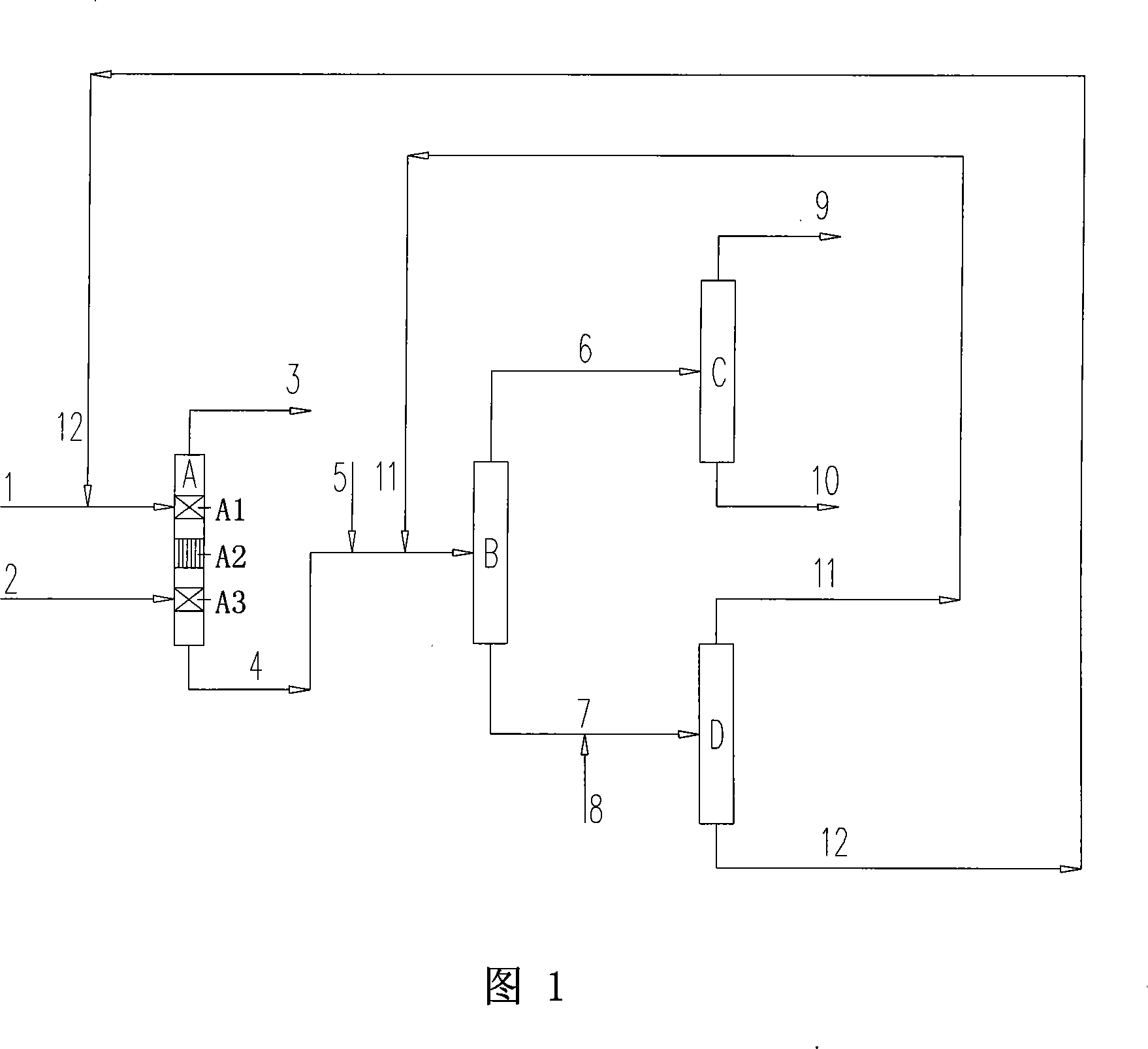Preparation method for sec-butyl acetate with product separating and reclaiming technique
A sec-butyl acetate and process technology, which is applied in the field of preparation of sec-butyl acetate, can solve problems affecting product purification, increase of olefin polymerization tendency, increase energy consumption, etc., and achieve product separation process simplification, energy consumption reduction, and production cost Reduced effect
- Summary
- Abstract
- Description
- Claims
- Application Information
AI Technical Summary
Problems solved by technology
Method used
Image
Examples
Embodiment 1
[0025] As shown in Figure 1, a strong acidic ion exchange resin is used as a catalyst, commercially available ZH-100 type. The catalyst in a total amount of 250 Kg was charged into the reaction section A2 of the catalytic distillation column A, and thus a catalyst layer was obtained.
[0026] Acetic acid 1, mix C 4 2 Enter the tower from the upper rectifying section A1 and the lower stripping section A3 of the catalytic distillation tower A respectively, and the two contact the catalyst surface in the reaction section A2 countercurrently, the acetic acid 1 and the mixed C 4 2 reaction generates sec-butyl acetate, unreacted mixed C 4 3 is distilled from the top of the column and the product mixture 4 is taken from the bottom of the column.
[0027] The operating conditions of catalytic distillation tower A are: tower top pressure 0.65MPa, tower top temperature 50°C, reaction section A2 middle temperature 100°C, tower kettle temperature 180°C, reflux ratio 5, acetic acid 1 ...
Embodiment 2
[0033] As shown in Figure 1, heteropolyacid is selected as the catalyst. A total of 10 L of the catalyst was charged into the reaction section A2 of the catalytic distillation column A, and thus a catalyst layer was obtained.
[0034] Acetic acid 1, mix C 4 2 Enter the tower from the upper rectifying section A1 and the lower stripping section A3 of the catalytic distillation tower A respectively, and the two contact the catalyst surface in the reaction section A2 countercurrently, the acetic acid 1 and the mixed C 4 2 reaction generates sec-butyl acetate, unreacted mixed C 4 3 is distilled from the top of the column and the product mixture 4 is taken from the bottom of the column.
[0035] The operating conditions of the catalytic distillation tower are: tower top pressure 0.5MPa, tower top temperature 52°C, temperature in the middle of reaction section A2 138°C, tower bottom temperature 155°C, reflux ratio 5, acetic acid 1 mixed with C 4 The molar ratio (acid-ene ratio)...
Embodiment 3
[0043] As shown in Figure 1, the catalyst selected in the catalytic distillation reaction stage and its preparation, the operating conditions of the catalytic distillation tower, the reaction steps, etc. are all the same as in Example 2, and the process of the azeotropic rectification of the resulting mixed product after the reaction and its control Condition is identical with embodiment 2, but the recovery process of reaction gained mixed product is carried out as follows.
[0044] Fraction 7 is extracted from the lower part of the azeotropic distillation tower, and its mass composition is: 12.10% of sec-butyl acetate, 77.69% of acetic acid, 5.93% of water, 4.28% of hydrocarbons and other substances. The fraction 7 extracted from the lower part of the azeotropic distillation tower is removed from the acid concentration tower D, and the entrainer benzene 8 is added to the acid concentration tower D at the ratio of benzene:water=91:9 (mass ratio). The temperature at the bottom ...
PUM
 Login to View More
Login to View More Abstract
Description
Claims
Application Information
 Login to View More
Login to View More - R&D
- Intellectual Property
- Life Sciences
- Materials
- Tech Scout
- Unparalleled Data Quality
- Higher Quality Content
- 60% Fewer Hallucinations
Browse by: Latest US Patents, China's latest patents, Technical Efficacy Thesaurus, Application Domain, Technology Topic, Popular Technical Reports.
© 2025 PatSnap. All rights reserved.Legal|Privacy policy|Modern Slavery Act Transparency Statement|Sitemap|About US| Contact US: help@patsnap.com



